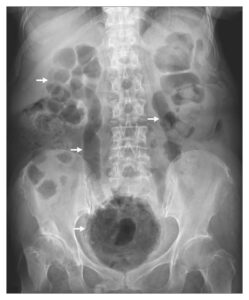This is an answer to the Case – Neovascular Lesion on Face
A 62-year-old man was referred to the hepatology clinic for evaluation of elevated levels of aspartate and alanine aminotransferase (385 U per liter and 356 U per liter, respectively), which were detected on routine laboratory examination.
The patient reported no symptoms except for a reddish lesion on his forehead. He had been previously told that the lesion was fungal in origin (tinea corporis), and a course of local antifungal treatment had been administered, with no improvement.
On physical examination the lesion on his face was determined to be a neovascular formation, with an arteriole in the central region that radiated out in numerous small vessels that resembled the legs of a spider. The lesion was about 3 cm in diameter.
Compression of the central arteriole caused the entire lesion to blanch, and it quickly refilled once the compression was released (video). This pattern of blanching and refilling characterizes spider angiomas, which are suggestive of liver disease.
Laboratory testing revealed infection with hepatitis C virus, genotype 1A, and a viral load of 4,920,000 IU per milliliter. Cirrhosis was diagnosed on liver biopsy. The patient was subsequently started on peginterferon alfa, but there has not been a sustained virologic response.

